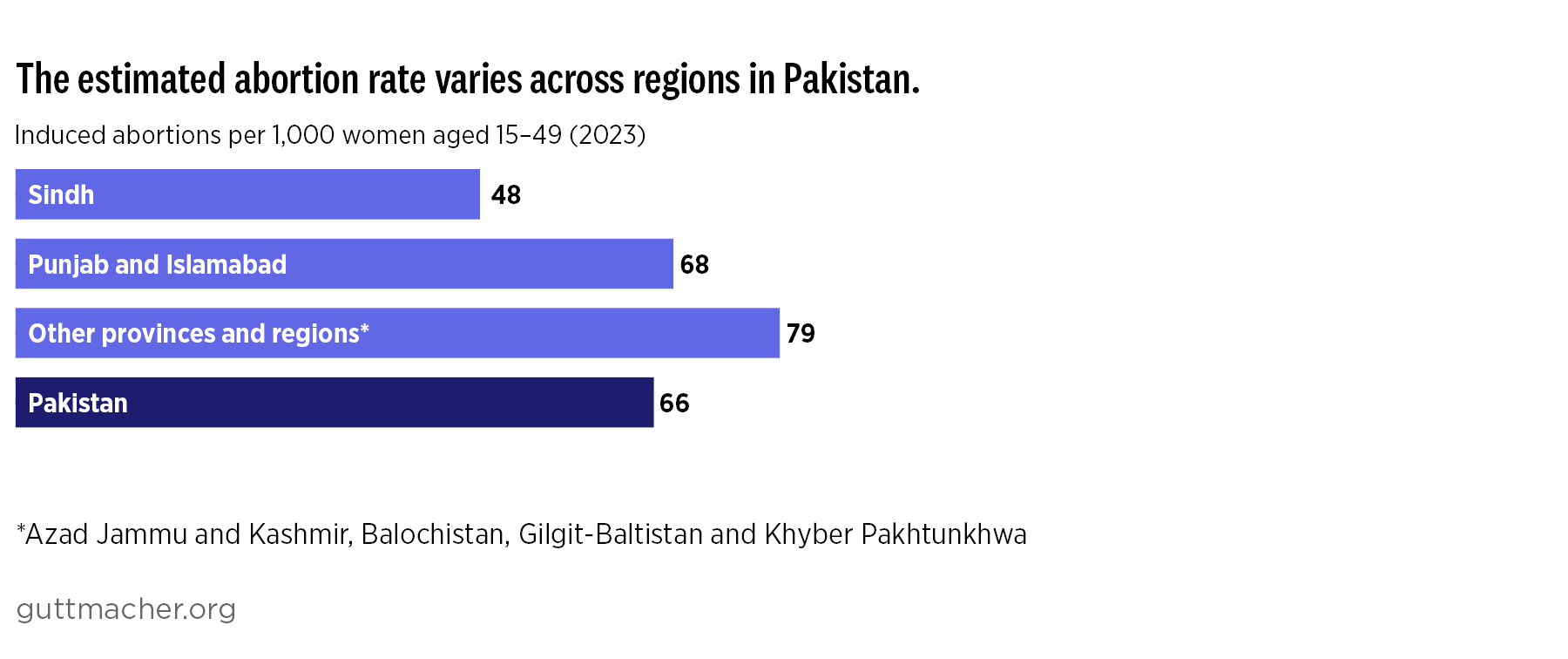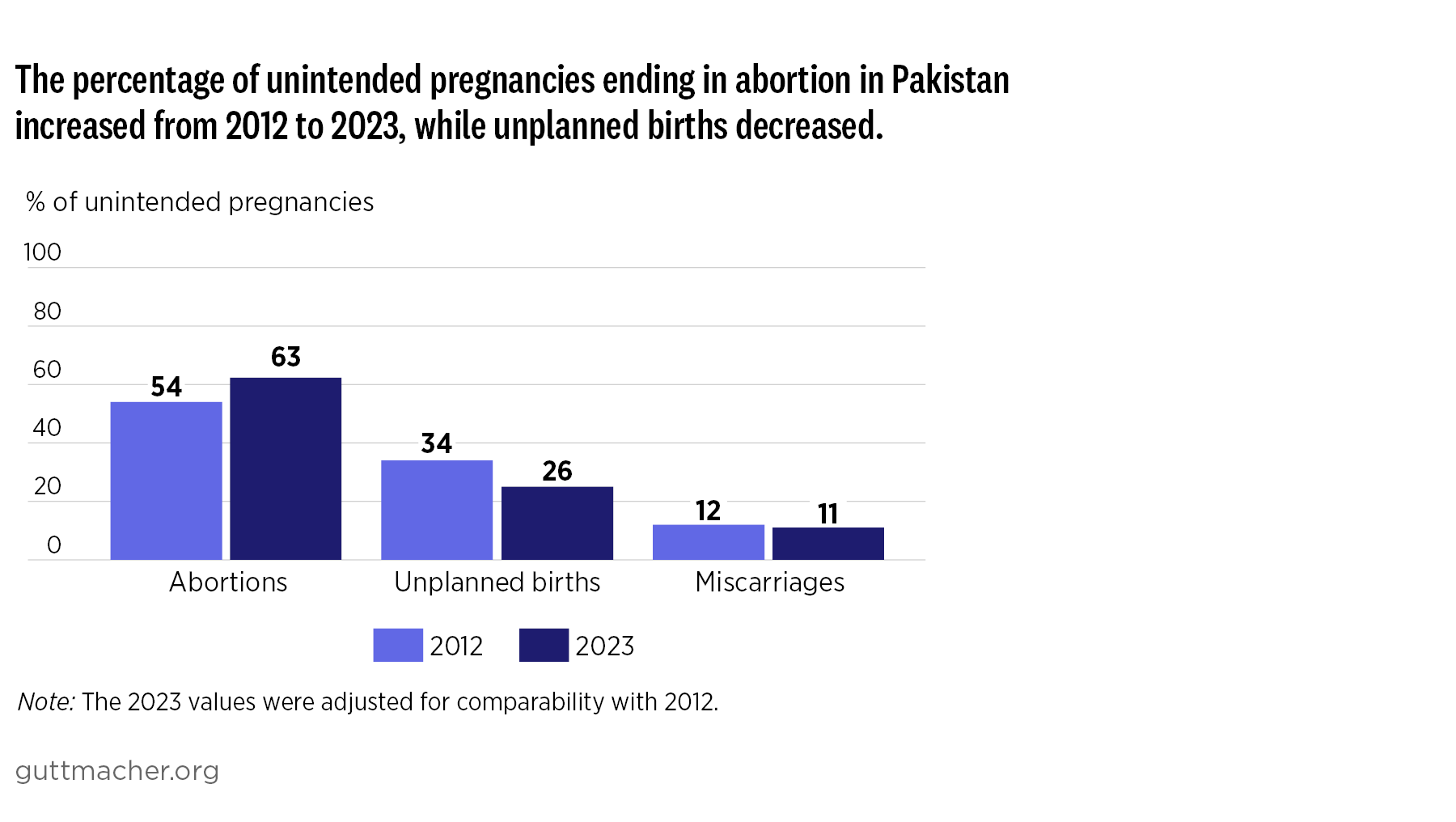Background
- In Pakistan, unintended pregnancies are widespread because unmet need for contraception is high: Some 17% of married women aged 15–49 are not using contraception despite wanting to avoid pregnancy.1
- Under Pakistani law, abortion is legal only to save a pregnant woman’s life or to provide “necessary treatment” early in pregnancy.2
- Complications of abortion and miscarriage contribute to roughly 10% of maternal deaths in Pakistan, which has a very high maternal mortality ratio (186 maternal deaths per 100,000 live births).1
Incidence of unintended pregnancy and induced abortion
- The unintended pregnancy rate in Pakistan—the sum of abortions, unplanned births, and miscarriages and stillbirths resulting from unintended pregnancies—is 104 per 1,000 women of reproductive age (15–49) as of 2023.1
- Nearly two-thirds of unintended pregnancies (64%) end in abortion and one-quarter (25%) in unplanned births.1
- As of 2023, an estimated 66 abortions occur each year per 1,000 women of reproductive age in Pakistan, which translates to 3.8 million abortions nationally.1
- The abortion rate in the combined grouping of Punjab province and Islamabad is 68.1
- The abortion rate is lowest in the province of Sindh (48) and highest (79) in a combined group of four areas—Azad Jammu and Kashmir, Balochistan, Gilgit-Baltistan and Khyber Pakhtunkhwa.1
Trends in unintended pregnancy outcomes and induced abortion
- The proportion of unintended pregnancies that women ended by abortion rose from 54% in 2012 to 63%* in 2023.1 Accordingly, the proportion ending in unplanned births fell from 34% to 26%.
- The annual number of abortions in the country increased by 56% from 2012 to 2023, partly because of population increases.1
- The annual rate of abortion increased by 25%, from 50 per 1,000 women to 63 per 1,000 women.1
Induced abortion complications and treatment
- As of 2023, an estimated 698,000 women across Pakistan receive treatment for complications of an abortion, an annual treatment rate of 12 cases per 1,000 women of reproductive age.1
- The widespread availability and use of misoprostol for clandestine abortions contributed to a 16% decline in treatment rates for abortion complications between 2012 and 2023, when comparing the same areas of the country.1
- Pharmacies have become an important source of misoprostol, contributing to the increased safety of abortions since the option of medication abortion first became available in Pakistan in the early 2000s.1,2
- Inequities persist in women’s access to safe abortion in Pakistan, with surveyed health professionals in the country estimating that the proportion of abortions likely to cause complications ranges from 21% among urban, nonpoor women to 30% among rural, poor women.2
Successes and challenges in the provision of postabortion services
- Misoprostol is now used to treat complications of abortion and miscarriage in the majority of public- and private-sector facilities across the country—64% of complications in public facilities were treated with misoprostol in 2023, compared with 39% in 2012.2
- As of 2023, an average of 62% of postabortion care nationally (including for miscarriages) is delivered in public-sector health facilities.1,2 Reliance on the public sector ranges widely across the country, from 52% of all postabortion care cases in Punjab and Islamabad to 85% in the combined group of Azad Jammu and Kashmir, Balochistan, Gilgit-Baltistan and Khyber Pakhtunkhwa.1
- More than 60% of postabortion care patients across Pakistan are treated at local, primary-care facilities, which are more accessible to women than higher-level health facilities.2
- One in five public facilities were not providing postabortion care in 2023, even though provision of such services has been mandated.3
- The quality of postabortion care remains a concern, with one-half of all facilities in Pakistan still using the non-recommended method of dilation and curettage (D&C) to treat some complications.2,3
- Many primary-level health facilities cannot promptly refer seriously ill patients to higher-level facilities for necessary treatment. Some 46% lack a phone to communicate the need to transfer a patient and 73% lack a functional ambulance for transportation.3
Conclusions and recommendations
- The increasing numbers and rates of abortion in Pakistan since 2012, despite being highly restricted legally, suggest that women now rely more on abortion than in the past to space or limit births.
- Improving the overall quality and accessibility of contraceptive services will enable more people to achieve their family planning goals and lead to reductions in unintended pregnancy and abortion.
- Efforts are needed to more fully implement the national postabortion care service delivery standards and guidelines mandating that all public health facilities in the country provide quality postabortion care.3

